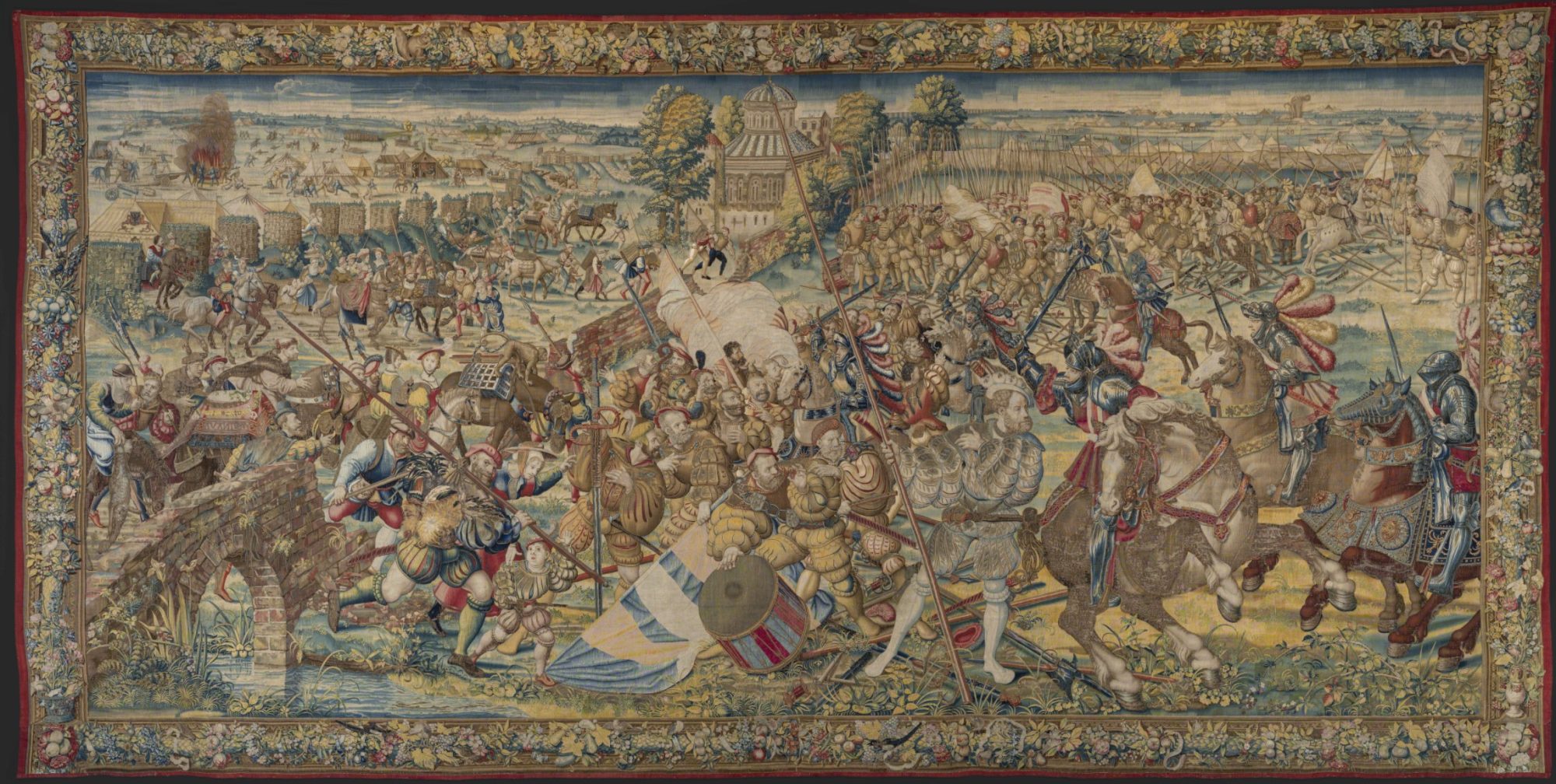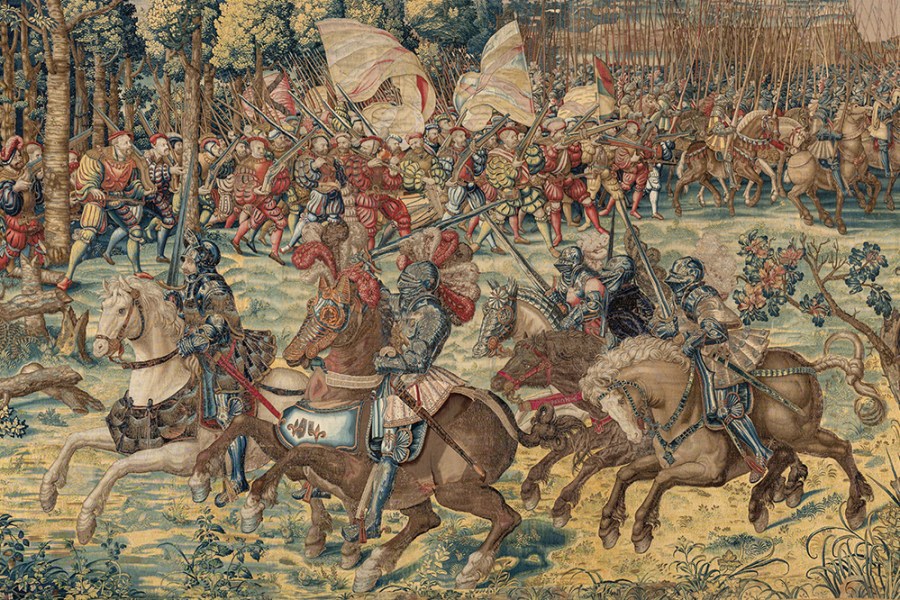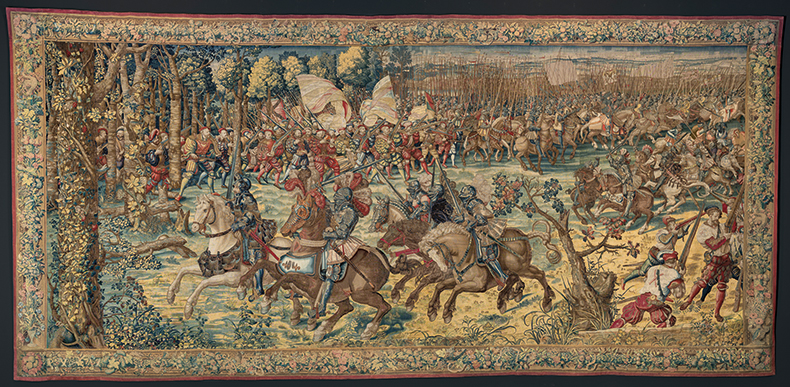The Kimbell Art Museum
June 16 through September 15
de Young Museum
October 19, 2024, to January 12, 2025,
Museum of Fine Arts
Spring 2025
The Kimbell Art Museum will debut Art and War in the Renaissance: The Battle of Pavia Tapestries from June 16 through September 15. Seven lavish tapestries depict the battle of Pavia, commemorating Holy Roman Emperor Charles V’s decisive victory over French King Francis I, which was a pivotal point in the Italian Wars almost five hundred years ago. The tapestries are monumental in scale—each measuring about twenty-eight feet wide and fourteen feet high—drawing viewers into the world of Renaissance history, military technology, and fashion. Narrative depictions of key moments from the battle are packed with near life-size figures and horses in full battle regalia, set within the scenography of the battlefield and countryside outside the besieged northern Italian city of Pavia.

Willem and Jan Dermoyen, after Bernard van Orley, The Incursion of the Imperial Baggage Train into the Battlefield, and the Surrender of the Swiss Pikemen of the French Army, c. 1528–31. Wool, silk, gold, and silver thread, 172 x 347 1/4 in. (437 x 882 cm). Museo e Real Bosco di Capodimonte, Naples]

King Francis I and his knights, in a detail from The Advance of the Imperial Army and Counterattack of the French Cavalry Led by King Francis I (c. 1528–31), Willem and Jan Dermoyen, after Bernard van Orley. Museo e Real Bosco di Capodimonte, Naples

The Advance of the Imperial Army and Counterattack of the French Cavalry Led by King Francis I (c. 1528–31), Willem and Jan Dermoyen, after Bernard van Orley. Museo e Real Bosco di Capodimonte,
NaplesVisitors will be fully immersed within these seven, splendid scenes—just as visitors to the court of Charles V would have been when the tapestries were first unveiled in 1531. After a careful restoration, which has returned them to their original splendor, the entire cycle of seven tapestries is being presented in the United States for the first time. Alongside the tapestries, impressive examples of precious arms and armor from the period evoke the human experience of war in the Renaissance. The exhibition is organized by the Museo e Real Bosco di Capodimonte and The Museum Box in collaboration with the Kimbell Art Museum, the Fine Arts Museums of San Francisco, and The Museum of Fine Arts, Houston.
“The Battle of Pavia tapestries are at once dazzlingly intricate works of fine art, powerful historical documents, and awe-inspiring visual narratives that will envelop visitors in early sixteenth-century art and history,” said Kimbell Art Museum director Eric Lee. “The Kimbell is proud to be the first-ever US venue to host the group of seven masterpieces. We are grateful to the museum in Naples and the Italian government for making the exhibition possible.”
During the Renaissance, monarchs and religious leaders glorified their power and wealth through the art of tapestry, commissioning some of Europe’s greatest artists to commemorate significant events through the lavish medium. Elaborate tapestries, much more costly than paintings, could serve as tools for dynamic storytelling and political propaganda, depicting histories in fine wool, silk, and metal-wrapped thread at monumental scale.
The seven Battle of Pavia tapestries are some of the most awe-inspiring examples of this often-overlooked yet highly prized Renaissance artform. They required remarkable feats of collaboration between artists and weavers—a single panel could take more than a year to produce. Designed by court artist Bernard van Orley, the tapestries were woven in Brussels by Willem and Jan Dermoyen in deeply saturated hues and exquisite detail, luxuriously highlighted with gold and silver thread. Each composition is filled with richly adorned military leaders, horsemen, and mercenary foot soldiers armed with swords, pikes, and firearms, all inhabiting a stunning panoramic landscape, from the walled park of the battleground to undulating hills in the distance. These tapestries were produced as works of art with timely subject matter: they were presented by the States General to Charles V in 1531, only six years after the battle, when he addressed the assembly of delegates representing the Low Countries at the Coudenberg Palace in Brussels.
Each of the tapestries depicts an episode of the conflict, though some of the events happened simultaneously, given the short duration of the battle. One tapestry shows the imperial baggage train arriving on the field of battle and the early surrender of the Swiss pikemen serving the French army. Another shows the most important political and tactical event of the conflict—the surrender of Francis I. Two tapestries show mass confrontations of the opposing forces, demonstrating a significant advancement in military history during the battle—the use of barrel-loaded firearms, which gave the imperial army a distinct advantage over the French troops. Another depicts the imperial army invading the French camp, forcing civilians in their retinue to flee. The remaining tapestries show the attack led by imperial loyalists from within the besieged Visconti Castle, which succeeded in routing the Swiss Guard in the service of Francis I, and, finally, the flight of Francis I’s brother-in-law, the Duke of Alençon, and his troops in the face of the unstoppable Spanish army serving Charles V.
“Imagine the scene when these glorious works of art were first put on view,” said George T. M. Shackelford, Kimbell deputy director. “The lucky members of the emperor’s court were surrounded by a massive, colorful panorama of a critical battle between two rivals—Francis I and Charles V—that had changed modern history. This summer, at the Kimbell, that splendid panorama will be available once again and on view in the United States for the first—and possibly only—time in history.”
The emperor left the tapestries in the care of his sister, Mary of Hungary, governor of the Netherlands. From her they passed to Don Carlos, the grandson of the emperor, who in turn bequeathed them to the family of one of the military heroes of the Battle of Pavia, Ferdinando (Ferrante) d’Avalos. In 1862, the d’Avalos family donated their noble collections to Naples’s national museum; since 1957, the tapestries have been displayed at the Museo e Real Bosco di Capodimonte in Naples.
Enhancing the visitor’s understanding and enjoyment of the woven depictions of battle, the exhibition will include a selection of arms and armor from Capodimonte’s renowned Farnese Armory. Among the most elegant objects on view will be a splendid helmet and rotella shield with episodes from Roman history, Pompeo della Cesa’s elegant “Volat” armor garniture, an exquisite arquebus made for Ranuccio Farnese by Giovanni Battista Visconti, and a variety of exquisitely detailed swords and firearms.
VENUES AND CATALOGUE
After its debut at the Kimbell, Art and War in the Renaissance: The Battle of Pavia Tapestries will be on view at the de Young Museum in San Francisco from October 19, 2024, to January 12, 2025, and the Museum of Fine Arts, Houston, in spring 2025. The exhibition is accompanied by a 208-page, full-color illustrated catalogue edited by Dr. Carmine Romano, curator and head of digitization and digital catalogue, Museo e Real Bosco di Capodimonte, with contributions by Romano; Dr. Sylvain Bellenger, general director, Museo e Real Bosco di Capodimonte; Dr. Thomas P. Campbell, director and CEO, Fine Arts Museums of San Francisco; Emma C. De Jong, postdoctoral curatorial fellow, The American Friends of Capodimonte; Graziella Palei, tapestry conservator; Dr. Cecilia Paredes, Université Libre de Bruxelles; Gennaro Sangiuliano, Minister of Culture, Italy; Cristina Del Sesto, president, the American Friends of Capodimonte; Antonio Tosini, conservator of the Farnese and Bourbon Armories, Museo e Real Bosco di Capodimonte; and H.E. Mariangela Zappia, Ambassador of Italy to the United States.